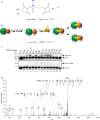Characterization of PPIB interaction in the P3H1 ternary complex and implications for its pathological mutations
- PMID: 30993352
- PMCID: PMC11105654
- DOI: 10.1007/s00018-019-03102-8
Characterization of PPIB interaction in the P3H1 ternary complex and implications for its pathological mutations
Abstract
The P3H1/CRTAP/PPIB complex is essential for prolyl 3-hydroxylation and folding of procollagens in the endoplasmic reticulum (ER). Deficiency in any component of this ternary complex is associated with the misfolding of collagen and the onset of osteogenesis imperfecta. However, little structure information is available about how this ternary complex is assembled and retained in the ER. Here, we assessed the role of the KDEL sequence of P3H1 and probed the spatial interactions of PPIB in the complex. We show that the KDEL sequence is essential for retaining the P3H1 complex in the ER. Its removal resulted in co-secretion of P3H1 and CRTAP out of the cell, which was mediated by the binding of P3H1 N-terminal domain with CRTAP. The secreted P3H1/CRTAP can readily bind PPIB with their C-termini close to PPIB in the ternary complex. Cysteine modification, crosslinking, and mass spectrometry experiments identified PPIB surface residues involved in the complex formation, and showed that the surface of PPIB is extensively covered by the binding of P3H1 and CRTAP. Most importantly, we demonstrated that one disease-associated pathological PPIB mutation on the binding interface did not affect the PPIB prolyl-isomerase activity, but disrupted the formation of P3H1/CRTAP/PPIB ternary complex. This suggests that defects in the integrity of the P3H1 ternary complex are associated with pathological collagen misfolding. Taken together, these results provide novel structural information on how PPIB interacts with other components of the P3H1 complex and indicate that the integrity of P3H1 complex is required for proper collagen formation.
Keywords: Chaperone; Hydroxylase; Hyperelastosis cutis; Osteogenesis imperfecta; Sulfo-GMBS.
Figures







Similar articles
-
The structural basis for the collagen processing by human P3H1/CRTAP/PPIB ternary complex.Nat Commun. 2024 Sep 8;15(1):7844. doi: 10.1038/s41467-024-52321-6. Nat Commun. 2024. PMID: 39245686 Free PMC article.
-
Mutations in PPIB (cyclophilin B) delay type I procollagen chain association and result in perinatal lethal to moderate osteogenesis imperfecta phenotypes.Hum Mol Genet. 2011 Apr 15;20(8):1595-609. doi: 10.1093/hmg/ddr037. Epub 2011 Jan 31. Hum Mol Genet. 2011. PMID: 21282188 Free PMC article.
-
Prolyl 3-hydroxylase 1 and CRTAP are mutually stabilizing in the endoplasmic reticulum collagen prolyl 3-hydroxylation complex.Hum Mol Genet. 2010 Jan 15;19(2):223-34. doi: 10.1093/hmg/ddp481. Epub 2009 Oct 21. Hum Mol Genet. 2010. PMID: 19846465 Free PMC article.
-
Null mutations in LEPRE1 and CRTAP cause severe recessive osteogenesis imperfecta.Cell Tissue Res. 2010 Jan;339(1):59-70. doi: 10.1007/s00441-009-0872-0. Epub 2009 Oct 28. Cell Tissue Res. 2010. PMID: 19862557 Free PMC article. Review.
-
Components of the collagen prolyl 3-hydroxylation complex are crucial for normal bone development.Cell Cycle. 2007 Jul 15;6(14):1675-81. doi: 10.4161/cc.6.14.4474. Epub 2007 May 18. Cell Cycle. 2007. PMID: 17630507 Review.
Cited by
-
The structural basis for the collagen processing by human P3H1/CRTAP/PPIB ternary complex.Nat Commun. 2024 Sep 8;15(1):7844. doi: 10.1038/s41467-024-52321-6. Nat Commun. 2024. PMID: 39245686 Free PMC article.
-
The Prognostic Significance and Potential Mechanism of Prolyl 3-Hydroxylase 1 in Hepatocellular Carcinoma.J Oncol. 2022 Oct 26;2022:7854297. doi: 10.1155/2022/7854297. eCollection 2022. J Oncol. 2022. PMID: 36339646 Free PMC article.
-
Type I and type V procollagen triple helix uses different subsets of the molecular ensemble for lysine posttranslational modifications in the rER.J Biol Chem. 2021 Jan-Jun;296:100453. doi: 10.1016/j.jbc.2021.100453. Epub 2021 Feb 23. J Biol Chem. 2021. PMID: 33631195 Free PMC article.
-
Pan-Cancer Analysis of P3H1 and Experimental Validation in Renal Clear Cell Carcinoma.Appl Biochem Biotechnol. 2024 Sep;196(9):5974-5993. doi: 10.1007/s12010-023-04845-8. Epub 2024 Jan 4. Appl Biochem Biotechnol. 2024. PMID: 38175417
-
Quantitative proteomics approach reveals novel biomarkers and pathological mechanism of keloid.Proteomics Clin Appl. 2022 Jul;16(4):e2100127. doi: 10.1002/prca.202100127. Epub 2022 Apr 26. Proteomics Clin Appl. 2022. PMID: 35435317 Free PMC article.
References
-
- Bächinger HP, Mizuno K, Vranka JA, Boudko SP. Collagen formation and structure. In: Mander L, Liu HW, editors. Comprehensive natural products II: chemistry and biology. Oxford: Elsevier; 2010. pp. 469–530.
-
- Myllyharju J. Intracellular post-translational modifications of collagens. Top Curr Chem. 2005;247:115–147. doi: 10.1007/b103821. - DOI
MeSH terms
Substances
Grants and funding
LinkOut - more resources
Full Text Sources

